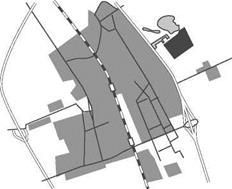Andre Viljoen
If Cuba can be considered a laboratory for the wide scale introduction of urban agriculture, it is not alone in planning for urban agriculture. Examples can be found in Asia, Africa and Europe. Although the conditions in each location are different, a number of common benefits can be identified.
DELFT, THE NETHERLANDS
The city of Delft in the Netherlands provides an interesting example of planning legislation being adapted to accommodate peri-urban agriculture. (Deelstra et al., 2001)
|
Urban agriculture in Upper Bieslandse Polder ] Urban areas – Road = Highway Railroad Water |
Figure 23.1
The Upper Bieslandse Polder has an area of thirty-five hectares and lies on the eastern edge of Delft. The land had been rented to farmers on short leases pending development. Collaboration between farmers, environmentalists and planners resulted in the city authorities granting a twelve – year lease to a farmer committed to organic dairy farming. This project demonstrates a number of benefits arising from urban agriculture. The organic farm includes designated areas for wildlife habitat, which have been located on the perimeter of the farm providing a transition between public and private land. Footpaths, cycle ways and bridal paths have been included in the plan, further intensifying the farmland use by including recreational areas for Delft’s inhabitants. Water meadows, marshy woodland and reed beds provide a degree of ecological water management. We could call this kind of environmental development, horizontal intensification. It contrasts sharply with the notion of vertical intensification currently being explored by many Dutch architects. Vertical intensification proposes a stacking of different activities and ecological systems within a multi-storey structure. Vertical intensification proposes highly engineered artificial landscapes. While horizontal intensification as found in the Upper Bieslandse Polder is also artificial, in that the land is managed, the inputs in terms of energy and materials are far less, and the outputs are almost entirely environmentally benign.
Although the proposal may be imperfect, in that it relates to a single example of land developing horizontal intensification, and it is impermanent (twelve years), it does indicate how policies are beginning to change in Europe.




